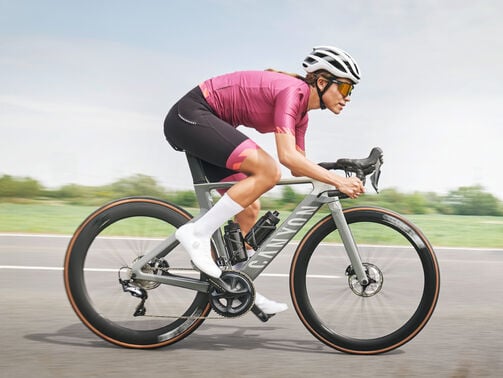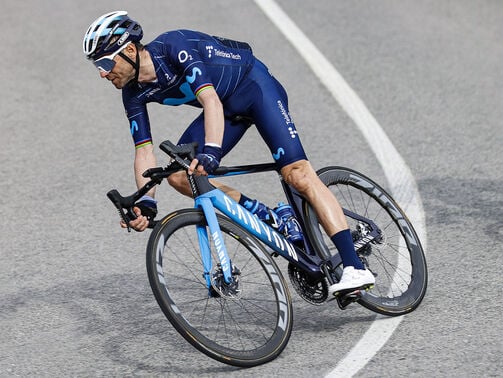Why an aero bike might be right for you
Wondering if you need an aerodynamic bike? Compare aero bikes vs road bikes to understand their unique benefits and decide which one fits your cycling goals and riding style.


Aero road bikes: with their futuristic looks and undeniable speed advantages, they can be somewhat divisive. More and more pros are using aero bikes, so why shouldn’t you?
We’re sure you’ve heard plenty about aero bikes. They look fast, and ride even faster. The sculpted, angular shapes have a brutalist, sci-fi flavour, and these are often the bikes that garner the splashiest headlines promising to make you ride a certain number of seconds quicker over a specific distance. Increasingly, they’re also the chosen option for professional road cyclists, who might only switch to their ‘regular’ or all-rounder road bike for the toughest climbing days.
What is an aero bike?
When we talk about an aero bike, we mean a road bike that is designed to offer lower wind resistance while still conforming to the rules set out by the Union Cycliste Internationale (UCI). In the past, building a faster bike primarily meant cutting down on weight, but modern high-end bikes are generally lighter than they used to be. With a UCI-mandated minimum weight for bikes used in road racing, there aren’t many more gains to be made in terms of shedding the grams.
By contrast, the benefits conferred by good aerodynamics continue to increase, as weights stay broadly static. Today it’s often better to be aero than light.
An aero bike is not to be confused with a time trial bike. Time trial bikes go much further in their pursuit of aerodynamic advantages, and they have their own definition from the UCI. They can be used in some professional cycling races, but only if it’s an individual or team time trial format. If you’re a time triallist or triathlete, you might be interested in our World Champs-winning bike, the Speedmax.

What does ‘aero’ mean in a bike context?
So how are these almost magical aero benefits achieved, and what does an aero road bike look like?
At first glance, you will notice that the frame tubes are thicker and may have quite peculiar shapes. The seat tube often clings to the curvature of the rear wheel, shielding it from the wind. Brakes, seat posts, and other components may be integrated into the frame. Cables and wires are hidden as well to offer less wind resistance, which is aided by specially designed combined handlebar and stem units – often known as ‘integrated cockpits’.
Carbon frames have come a long way since the early days of the aero revolution. Thanks to modern frame building techniques, a good aero bike will still offer just as much vertical comfort as a more traditional frame style. However, its geometry will often be optimised for a more aggressive riding position, with a lower stack-to-reach ratio (around 1.45 or less) and a shorter head tube (around 140 mm). This means you will sit on the bike with your torso down low, while a seat angle between 73 and 74 degrees keeps you centred above the bottom bracket for maximum power transfer. Check out our deep dive into road bike geometry for more on this nerdy-but-fascinating subject.
Having the right set of wheels on your racing bike can maximise straight line speed, and even make use of the so-called ‘sailing effect’, where the correct rim profiles can act like a wing or sail to generate additional propulsion at certain yaw angles. This is especially noticeable with high-profile wheels and at high speeds. The larger the surface of your rims, the lower the wheel’s overall air resistance. However, with rim depths ranging from 40 to 80mm, aero wheels carry a weight penalty and can be less stable in crosswinds.
Sitting somewhere closer to the time trial bike than an aero road bike in terms of looks is the aerodynamic track bike. These, like a TT or triathlon rig, are not UCI legal for road racing – and have been developed with the Olympic indoor cycling disciplines in mind. The Speedmax CFR Track is the result of an unprecedented pro athlete-driven development process, with input from eight-time gold medallist at UCI Track Worlds, Chloe Dygert.

How to get aero on your bike
In cycling, 75% of the air resistance is caused by the rider, not the bike. That means your seating position should be as low as possible, but not so low that it negatively affects your performance because it hinders digestion or breathing.
The most aerodynamic place to have your hands while on a road bike will always be the drop part of your handlebars, as this pulls your whole torso forward, closer to the top of your bike frame. You’ll also want to keep your upper body as still as you can manage to minimise drag generated by movement of your torso. This takes time to get good at, as does building up the strength and flexibility to maintain that aero tucked position.
While riding on the hoods, you can simply tuck your elbows in to get more aero. Of course, your kit makes a huge difference as well: if you’re still riding in baggy shorts and a T-shirt, the best way to boost your aerodynamics will be changing into a purpose-made cycling jersey and bib shorts. For maximum aero gains, you could go one step further and invest in a skinsuit and an aero helmet.

Aero bike vs road bike: which is right for you?
When shopping for a road bike, the choice you will face is whether to buy an aero road bike or a more traditional road bike. These days the latter are often referred to as all-rounder bikes, offering the rider a balance between streamlined speed, handling agility for descents and cornering, and low weight for better climbing.
Starting at speeds around 21 kph, aerodynamic drag becomes the single most important factor in whether a bike goes fast, so even amateurs can benefit significantly from a more aerodynamic design. The only situation where a traditional superlight road bike like our Ultimate will beat its more aerodynamic counterparts is when it comes to long, slow climbs at steeper gradients.
Aero bikes are often associated with sprinting and flat parcours, but the watts you save will add up over long distances as well. The Canyon Aeroad has been used by pros to win anything from cobbled classics to Grand Tour mountain stages.
If speed is the main thing you want from your road bike, aero is probably the answer. However, there is still something to be said for the more classical beauty of a conventional road frame – not to mention the unbeatable sensation of dancing on the pedals on a steep climb, as your lightweight bike responds nimbly to the power you’re putting down.
Often it comes down to context of where you do your cycling. If you live somewhere fairly flat, go with the aero bike. If you live amidst the mountains, choose an all-rounder. If you still have questions about which style will give you the most enjoyment, you might find them answered in our road bike buyer’s guide.
Despite their (undeserved and outdated) rep for being heavy and uncomfortable, today’s aero bikes are every bit as versatile as other race bikes. Whether you prefer electronic or mechanical shifting, disc or rim brakes: take a look at our Canyon Aeroad family to find the right setup for you! Or, if you want to weigh up a couple of our bikes and see their relative strengths, check out our bike comparison tool which lets you pore over the details of any pair of bikes on the Canyon website.
Did this article help?
Thank you for your feedback




